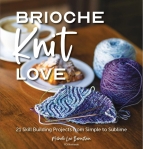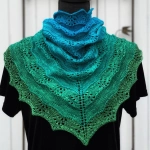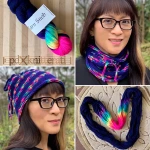I always say that blocking is magic. Especially with lace. But even then, I’m always astonished at the transformation.
Here’s my Nymphaea shawl, right off the needles, no blocking, no weaving in the ends. It’s pretty small, 48 inches across the top eyelet edge, 20 inches at the wide end, not including the lace edging in either measurement.
I wet blocked it; it pinned out to be 60 inches across the top eyelet edge, and 30 inches across the wide end, just above the lace edging. Where it was once thick and chunky, it’s now ethereally and diaphanously lovely. It’s almost as big as the sample I knit last fall with the mini skein gradient kit, just nine repeats instead of ten.
 Lacy border, this time with beads
Lacy border, this time with beads
I knit this in Bumblebirch Heartwood, 75/25 superwash merino/nylon. The colors are Atlantic and Hellebore, the same colors in my Tumbling Leaves, but reversed. I love it, and I love the beads, too. Depending on how you look at them, they’re blue, or green. Perfect.
I’m going to knit one more of these, a sample with a Fierce Fibers 650 yard continuous gradient, and a semisolid contrast color. This is in preparation for our Fall Shawl Retreat in November. Registration opens August 1, and the price will include yarn and beads for a knit or crochet version of Nymphaea.
While knitting this shawl, I started thinking about my personal rules for SSK. When I first learned SSK, I did them conventionally, slipping both stitches as if to knit. The result is a left leaning decrease, exactly the same as SKP: Slip one (knitwise), knit one, pass slip stitch over. The passed stitch could sometimes be stretched out and unsightly; Barbara Walker invented the SSK as an improvement on the SKP.
Eventually, Elizabeth Zimmermann figured out that slipping the second stitch purlwise instead of knitwise made this decrease lie flatter, and mirror the right leaning K2tog better. It’s less zigzaggy. I learned this from her daughter Meg Swansen in a class oh so long ago, and adopted it as my go-to SSK. For me, it’s quicker to execute (don’t have to pull left needle out of the second slipped stitch before ktbl).
But! When I was designing my Meander Cowl, I noticed that this SSK looked wide and bumpy when it met up with a YO on its left side. It’s because the right leg of the stitch shows a bit more prominently behind the left leaning stitch on top. Subtle, yes, but there.
So, my personal SSK rule: Slip the second stitch as if to purl when working stockinette. But if there’s a YO to the left of the SSK, slip the second stitch as if to knit. Try them both, if you like. You’re the boss of your knitting; as long as you get the result you want, you’re doing it right! Here’s a video on the whole thing.
How do you SSK?


























Great analysis of the SSK!
Thank you! A little nerdy, but I’m picky! Sometimes. I may break my own rule on the last Nymphaea; the EZ way is so much quicker for me and it will be a BIG shawl. But at least I’ll know my options and make a reasoned choice.
>
I slip the second stitch purlwise, but I will be giving your tip a try.
Slipping the second stitch purlwise is faster for me (just roll the left needle up and then through the first slipped st, no need to take it out and put it back in), so it’s my preferred method. Just not in lace next to a YO!
>